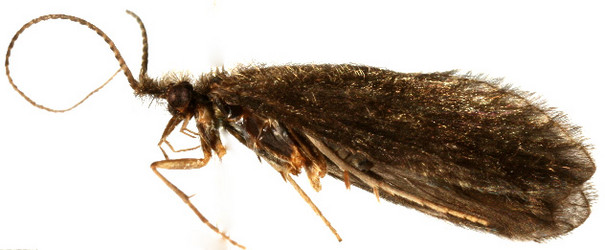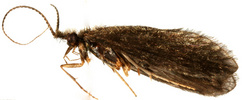Lepidostomatidae
Ralph W. Holzenthal, Roger J. Blahnik, Aysha Prather, and Karl Kjer


This tree diagram shows the relationships between several groups of organisms.
The root of the current tree connects the organisms featured in this tree to their containing group and the rest of the Tree of Life. The basal branching point in the tree represents the ancestor of the other groups in the tree. This ancestor diversified over time into several descendent subgroups, which are represented as internal nodes and terminal taxa to the right.

You can click on the root to travel down the Tree of Life all the way to the root of all Life, and you can click on the names of descendent subgroups to travel up the Tree of Life all the way to individual species.
For more information on ToL tree formatting, please see Interpreting the Tree or Classification. To learn more about phylogenetic trees, please visit our Phylogenetic Biology pages.
close boxIntroduction
This family is widely distributed throughout the Northern Hemisphere, and extends southward to Panama, New Guinea, and the Afrotropical region. It was originally described by Ulmer (1903) as a subfamily of Sericostomatidae. The nominotypical subfamily contains 3 genera and most of the species: Hummeliella Forsslund is a monotypic genus from China; Lepidostoma Rambur contains most of the diversity in the family (ca. 380 species; Afrotropical, Australasian, Palearctic, and Nearctic); and Paraphlegopteryx Ulmer (ca. 20 species) is widespread in the East Palearctic and Oriental regions. The subfamily Theliopsychinae Weaver, 1993 contains 4 genera: Crunoecia McLachlan and Martynomyia Fischer are West Palearctic genera with only a handful of species each; Theliopsyche Banks is a Nearctic genus with half a dozen species; and Zephyropsyche Weaver is a small genus (4 species) from South and Southeast Asia. Larval cases are generally square in cross section and constructed of quadrate leaf or bark pieces. Some species build cylindrical cases of sand grains as early instars and switch to 4-sided cases as they mature; a few retain the sand grain cases throughout larval development. Larvae are generally inhabitants of cool streams and springs, but they may also occur along the shorelines of lakes. They are primarily detritivores. Weaver (1988) provided a synopsis of the North American species and a review of the world species (Weaver 2002), where he synonymized several genera, formerly separated by secondary sexual characters of the male, with Lepidostoma. Myers and Sperling (2002) looked at the relationships of the subgenera of Lepidostoma, based on mitochondrial DNA sequence data. (From Holzenthal et al., 2007)References
Holzenthal R.W., Blahnik, R.J., Prather, A.L., and Kjer K.M. 2007. Order Trichoptera Kirby 1813 (Insecta), Caddisflies. In: Zhang, Z.-Q., and Shear, W.A. (Eds). 2007 Linneaus Tercentenary: Progress in Invertebrate Taxonomy. Zootaxa. 1668:639–698.
Myers, M.J. & Sperling, F.A.H. (2002) Preliminary evaluation of subgeneric designations within the caddisfly genus Lepidostoma (Rambur) (Trichoptera: Lepidostomatidae) based on mtDNA sequences. Nova Supplementa Entomologica (Proceedings of the 10th International Symposium on Trichoptera), 15, 187–194.
Ulmer, G. (1903) Ueber die Metamorphose der Trichopteren. Abhandlungen des Naturwissenschaftlichen vereins in Hamburg, 18, 1–154.
Weaver, J.S., III. (1988) A synopsis of the North American Lepidostomatidae (Trichoptera). Contributions of the American Entomological Institute, 24, 1–141.
Weaver, J.S. (2002) A synonymy of the caddisfly genus Lepidostoma Rambur (Trichoptera: Lepidostomatidae), including a species checklist. Tijdschrift voor Entomologie, 145, 173–192.
Title Illustrations

| Scientific Name | Lepidostoma bryanti |
|---|---|
| Specimen Condition | Dead Specimen |
| Life Cycle Stage | Adult |
| View | Lateral |
| Source Collection | Barcode of Life Database (BOLD) |
About This Page
Ralph W. Holzenthal

University of Minnesota, St. Paul, Minnesota, USA
Roger J. Blahnik

University of Minnesota, St. Paul, Minnesota, USA
Aysha Prather

Centre for Biodiversity and Conservation Biology, Royal Ontario Museum, Toronto, Ontario, Canada
Karl Kjer

Rutgers University, New Brunswick, New Jersey, USA
Correspondence regarding this page should be directed to Ralph W. Holzenthal at , Roger J. Blahnik at , Aysha Prather at , and Karl Kjer at
Page copyright © 2010 Ralph W. Holzenthal, Roger J. Blahnik, Aysha Prather, and Karl Kjer
 Page: Tree of Life
Lepidostomatidae.
Authored by
Ralph W. Holzenthal, Roger J. Blahnik, Aysha Prather, and Karl Kjer.
The TEXT of this page is licensed under the
Creative Commons Attribution-NonCommercial-ShareAlike License - Version 3.0. Note that images and other media
featured on this page are each governed by their own license, and they may or may not be available
for reuse. Click on an image or a media link to access the media data window, which provides the
relevant licensing information. For the general terms and conditions of ToL material reuse and
redistribution, please see the Tree of Life Copyright
Policies.
Page: Tree of Life
Lepidostomatidae.
Authored by
Ralph W. Holzenthal, Roger J. Blahnik, Aysha Prather, and Karl Kjer.
The TEXT of this page is licensed under the
Creative Commons Attribution-NonCommercial-ShareAlike License - Version 3.0. Note that images and other media
featured on this page are each governed by their own license, and they may or may not be available
for reuse. Click on an image or a media link to access the media data window, which provides the
relevant licensing information. For the general terms and conditions of ToL material reuse and
redistribution, please see the Tree of Life Copyright
Policies.
- First online 17 July 2010
- Content changed 20 July 2010
Citing this page:
Holzenthal, Ralph W., Roger J. Blahnik, Aysha Prather, and Karl Kjer. 2010. Lepidostomatidae. Version 20 July 2010 (under construction). http://tolweb.org/Lepidostomatidae/14611/2010.07.20 in The Tree of Life Web Project, http://tolweb.org/







 Go to quick links
Go to quick search
Go to navigation for this section of the ToL site
Go to detailed links for the ToL site
Go to quick links
Go to quick search
Go to navigation for this section of the ToL site
Go to detailed links for the ToL site